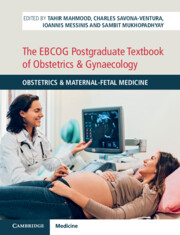Book contents
- The EBCOG Postgraduate Textbook of Obstetrics & Gynaecology
- The EBCOG Postgraduate Textbook of Obstetrics & Gynaecology
- Copyright page
- Dedication
- Contents
- Contributors
- Preface
- Section 1 Basic Sciences in Obstetrics
- Section 2 Early Pregnancy Problems
- Section 3 Fetal Medicine
- Section 4 Maternal Medicine
- Section 5 Intrapartum Care
- Section 6 Neonatal Problems
- Section 7 Placenta
- Section 8 Public Health Issues in Obstetrics
- Section 9 Co-Morbidities during Pregnancy
- Chapter 72 Management of Malignant and Premalignant Disease of the Cervix during Pregnancy
- Chapter 73 Breast Cancer and Pregnancy
- Chapter 74 Gynaecological Cancers and Pregnancy
- Chapter 75 Non-Gynaecological Cancers and Pregnancy
- Chapter 76 Simulation for Obstetric Emergencies
- Index
- Plate Section (PDF Only)
- References
Chapter 76 - Simulation for Obstetric Emergencies
from Section 9 - Co-Morbidities during Pregnancy
Published online by Cambridge University Press: 20 November 2021
- The EBCOG Postgraduate Textbook of Obstetrics & Gynaecology
- The EBCOG Postgraduate Textbook of Obstetrics & Gynaecology
- Copyright page
- Dedication
- Contents
- Contributors
- Preface
- Section 1 Basic Sciences in Obstetrics
- Section 2 Early Pregnancy Problems
- Section 3 Fetal Medicine
- Section 4 Maternal Medicine
- Section 5 Intrapartum Care
- Section 6 Neonatal Problems
- Section 7 Placenta
- Section 8 Public Health Issues in Obstetrics
- Section 9 Co-Morbidities during Pregnancy
- Chapter 72 Management of Malignant and Premalignant Disease of the Cervix during Pregnancy
- Chapter 73 Breast Cancer and Pregnancy
- Chapter 74 Gynaecological Cancers and Pregnancy
- Chapter 75 Non-Gynaecological Cancers and Pregnancy
- Chapter 76 Simulation for Obstetric Emergencies
- Index
- Plate Section (PDF Only)
- References
Summary
Appropriate management of obstetric emergencies requires the immediate coordinated action of multidisciplinary and multiprofessional teams, composed of midwifes, obstetricians, anaesthetists and neonatologists. As most of these emergencies do not happen very frequently and are unforeseeable, adequate regular training of skills and communication is essential. Most often, the situation is charged with emotions; suddenly, not only the mother but also the fetus or the newborn might be involved, and communication within the team and to the patient becomes impaired.
- Type
- Chapter
- Information
- The EBCOG Postgraduate Textbook of Obstetrics & GynaecologyObstetrics & Maternal-Fetal Medicine, pp. 623 - 627Publisher: Cambridge University PressPrint publication year: 2021

